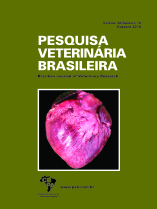 |
|
|
|
Year 2018 - Volume 38, Number 10
|

|
Outbreak of neonatal diarrhea caused by multiple genotypes of rotavirus A in a beef calves herd, 38(10):1890-1895
|
ABSTRACT.- Rondelli A.L.H., Rondelli L.A.S., Monteiro B.R.G., Lorenzetti E., Tineli T.R., Dutra V., Alfieri A.A & Pescador C.A. 2018. Outbreak of neonatal diarrhea caused by multiple genotypes of rotavirus A in a beef calves herd. [Surto de diarreia neonatal por múltiplos genótipos de rotavírus A em um rebanho de bovinos de corte.] Pesquisa Veterinária Brasileira 38(10):1890-1895. Laboratório de Patologia Veterinária, Faculdade de Medicina Veterinária, Universidade Federal de Mato Grosso, Av. Fernando Corrêa da Costa 2367, Cuiabá, MT 78060‑900, Brazil. E-mail: carolpescador@yahoo.com.br
Calf diarrhea causes substantial economic losses to beef cattle production worldwide. It is a complex multifactorial pathological condition influenced by infectious, nutritional and environmental factors. The present study focused on analyzing the pathological and molecular characterization of bovine rotavirus A (BoRVA) during a diarrhea outbreak in a beef cattle herd located in the state of Mato Grosso, central-western region, Brazil. The outbreak caused high morbidity (80%) and mortality (12%) among 1,100 calves up to 30 days of age. The BoRVA was identified in 53.3% (16/30) of the diarrheic fecal samples analyzed using the silver-stained polyacrylamide gel electrophoresis (ss-PAGE) technique. The nucleotide sequence analysis of VP7 (G genotype) and VP4 (P genotype) via RT-PCR from eight BoRVA-positive fecal samples showed the genotypes G6P[5] (n = 6), G6P[11] (n = 1) and G6P[X] (n = 1). Three calves were necropsied and the gross findings included edema and thickened, wrinkled bowel mucosa in the small intestine. Microscopic lesions were confined to the villi of the small intestine, characterized mainly by villus fusion and moderate multifocal lymphoplasmacytic enteritis. Immunohistochemical examination of three cases was positive for BoRVA. The 53.3% of the diarrheic fecal samples that were positive for BoRVA in this study suggested that RV was the etiological agent involved in this neonatal calf diarrhea outbreak. |
| |
|
|
| |
|
 |